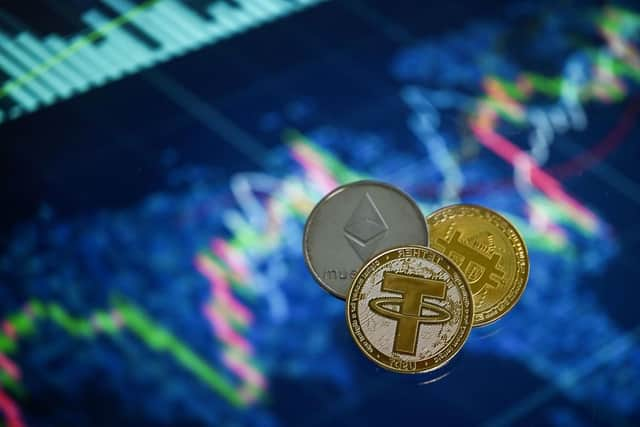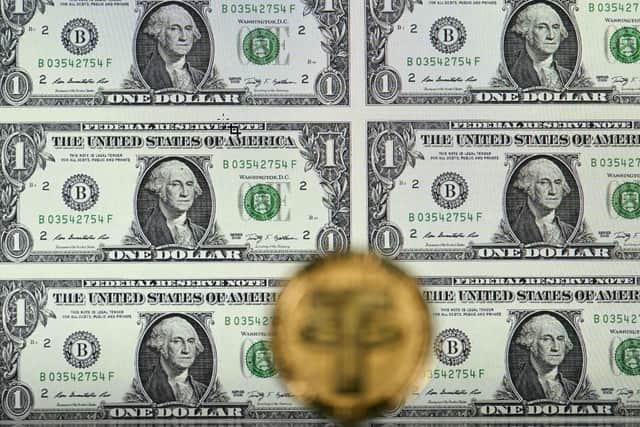Will Terra Luna recover? Cryptocurrency price crash news, USD and UST meaning - and should I buy stablecoins
and live on Freeview channel 276
Terra (LUNA) investors are panicking after the cryptocurrency's value plunged by more than 98 percent in only 24 hours earlier this week
Terra, which was once among the top ten most valuable cryptocurrencies, fell below $1 (£0.82) on Wednesday (11 May) after peaking at $120 (£98.60) last month.
Advertisement
Hide AdAdvertisement
Hide AdThe sudden meltdown saw its market cap plummet from almost $40 billion (£32.9 billion) to only $500 million (£411 million), triggering catastrophic losses.
So why has it so dramatically dropped in value, and will it ever bounce back?
Here is everything you need to know about it.
What is Terra (LUNA)?
Terra is a South Korean-based cryptocurrency.
It was founded in January 2018 by Daniel Shin and Do Kwon of Terraform Labs, and according to cryptocurrency website CoinMarketCap, Terra is “a price-stable cryptocurrency aimed at mass adoption” in South Korea.
“Its mission is to free people from the hidden fees that are embedded in everyday international payments,” says this Medium article. “They aim to strip away inefficiencies by using blockchain technology to offer stability and adoption by e-commerce platforms.”
Advertisement
Hide AdAdvertisement
Hide AdIt’s essentially a cryptocurrency of two halves: the ‘stablecoin’ (more on that in bit) Terra, and Luna, a much more ‘traditional’ cryptocoin.


Terra is designed to always be worth US dollar (USD) in real-world money, and while Luna’s price fluctuates with the market, one Terra will always get you $1 worth of Luna, and $1 worth of Luna one Terra.
That means that should Terra trade for more than $1, traders can acquire $1 worth of Luna and exchange it for a Terra worth more than a dollar = profit.
If Terra trades for less than a dollar, people can buy one Terra and exchange it for $1 worth of Luna = profit.
Advertisement
Hide AdAdvertisement
Hide AdThat means that - in theory - should one crash in value, investors will simply exchange their holdings for the other half of the coin, making themselves a quick buck and restoring the price of the flailing crypto asset.
It’s a self-regulating mechanism that couldn’t possibly go wrong. Could it?
Why has it crashed?
The Terra crash comes amid a broader crypto market downturn, with bitcoin down more than 50% from its all-time high of close to $69,000 (£56,677) in November 2021.
In the wake of the downturn, leading crypto market Binance briefly banned all Terra network withdrawals, preventing even those who wanted to sell from doing so.
Advertisement
Hide AdAdvertisement
Hide AdBut the demise of Luna has been exacerbated by problems with Terra’s dollar-pegged stablecoin, UST.
What is a stablecoin?


Stablecoins are cryptocurrencies whose value is usually tied to a physical asset, such as a ‘real world’ currency, or traded commodities like precious or industrial metals.
Because they are stabilised by assets that vary outside of the highly fluid cryptocurrency space, they are designed to be less volatile than other cryptocurrencies.
Since the price of Bitcoin and other cryptocurrencies are strongly connected, cryptocurrency holders cannot avoid broad price drops without abandoning the market entirely or investing instead in asset-backed stablecoins.
Advertisement
Hide AdAdvertisement
Hide AdSince the value of a stablecoin is usually tied to a real-world asset, they are unlikely to fall below the value of those underlying physical commodities.
In theory, holders of such coins are also able to cash in their cryptocurrencies in exchange for the real-world equivalence at any time.
It’s not always that simple though, and some stablecoins like Tether - the biggest by market capitalisation - have faced criticism for not being able to provide audits for the reserves of physical assets they are supposed to maintain.
What is UST?
Technically, Terra itself is not a stablecoin, but is ‘pegged’ to one in UST.
Advertisement
Hide AdAdvertisement
Hide AdSince UST is tied to the value of the US dollar, its price - and therefore that of Terra - was thought to be much more secure.
UST is a little bit different to traditional stablecoins. It is an “algorithmic stablecoin”, which means it doesn’t hold physical reserves, and instead employs a complicated system of "smart contracts" to keep the value as close to $1 as is feasible.
However, UST decoupled from the dollar earlier this week, with the once stablecoin’s value falling to as low as $0.29.
Things have become so dire, many investors feel the UST project may never recover; following its crash investors raced to liquidate their positions (in both Terra and Luna) quicker than the currency’s the automatic stabilisers could kick in.
Advertisement
Hide AdAdvertisement
Hide AdThis caused the sophisticated algorithmic mechanism that was supposed to keep Terra trading at a fixed price to fail, rendering both sides of it near worthless.
Will Terra (LUNA) bounce back?
The Luna Foundation Guard, which acts as steward for UST, is currently aiming to fund over $1 billion to resurrect the stablecoin.
Do Kwon, who founded Terra creators Terraform Labs, tweeted on Tuesday (10 May): “Close to announcing a recovery plan for $UST. Hang tight.”
On Wednesday (11 May), he followed up with a Twitter thread, asking for the community’s patience.
Advertisement
Hide AdAdvertisement
Hide Ad“I understand the last 72 hours have been extremely tough on all of you,” he said. “Know that I am resolved to work with every one of you to weather this crisis, and we will build our way out of this.
“The Terra ecosystem is one of the most vibrant in the crypto industry, with hundreds of passionate teams building category defining applications within... Terra’s return to form will be a sight to behold.”
But for now, it’s probably best to hold off on investing in the beleaguered cryptocurrency.
Terra was viewed as a promising step forward in cryptofinance, and buoyed by its success, even utilised its reserves to purchase a huge stake in bitcoin.
Advertisement
Hide AdAdvertisement
Hide AdBut, if Terra can experience such a drastic drop in value, what’s stopping other similar coins from doing the same?
Could Tether - the largest stablecoin - follow in its footsteps? And what happens then?
Comment Guidelines
National World encourages reader discussion on our stories. User feedback, insights and back-and-forth exchanges add a rich layer of context to reporting. Please review our Community Guidelines before commenting.
